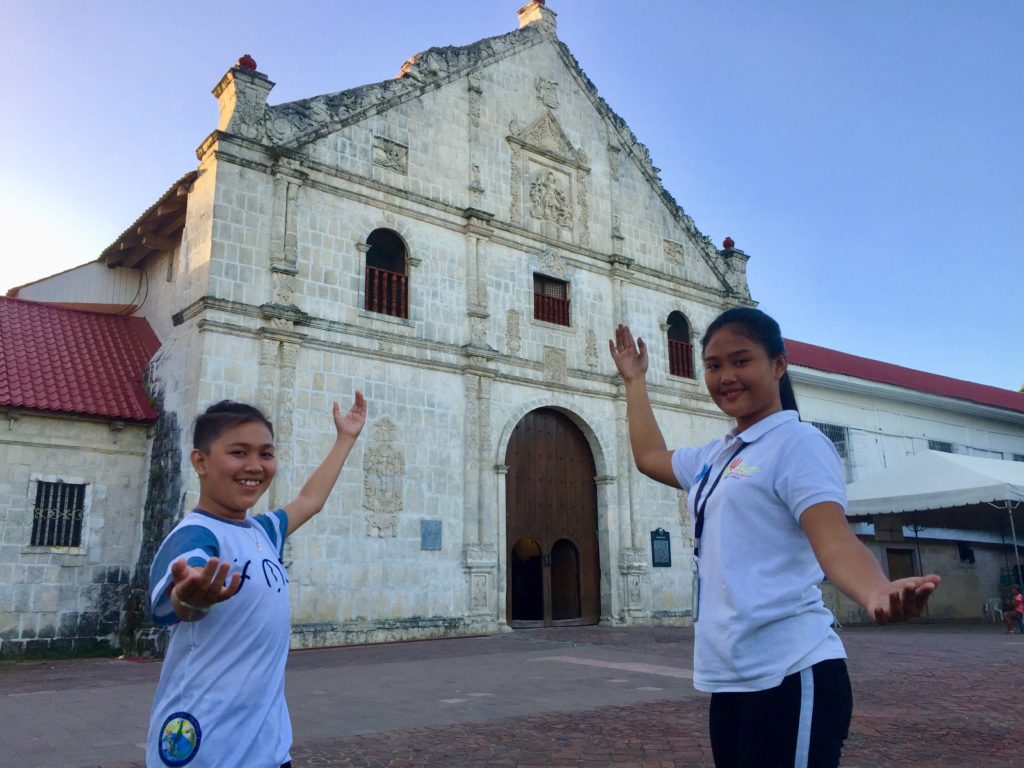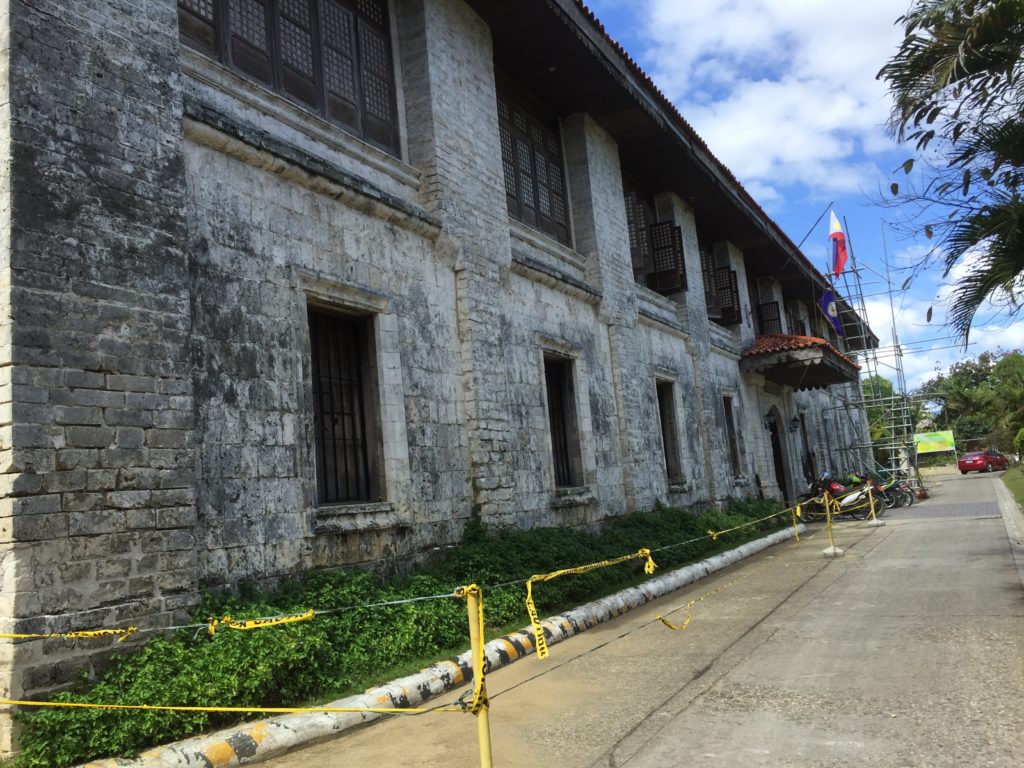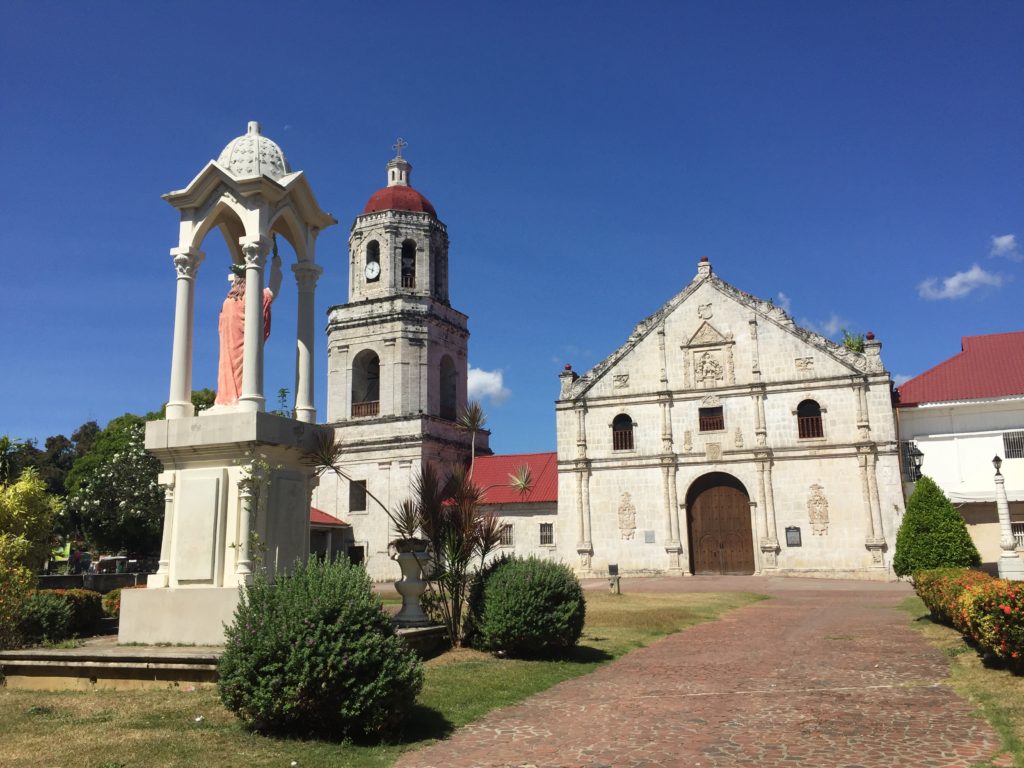Kid-tour guides help keep Argao’s heritage alive

Novem Lao, 19, (left) and Aimie Rumaguera, 18, (right) are one of the youth tourists guides of Argao. | Delta Dyrecka Letigio
ARGAO, Cebu, Philippines—The stories of the old no longer stay with the old as these stories are now fresh in the minds of the youth of Argao while they bring in tourists to appreciate the heritage of their town.
At least 60 kilometers away from Cebu City, the southern Cebu town of Argao boasts that much of their heritage are well preserved in the Cabisera of their town center, which, at first glance, is a smaller version of the old town of Vigan in Ilocos Sur.
The pride of Argaoanons remains in the structures left from the Spanish era that have been continuously preserved over the years in a series of restoration projects.
Furthermore, the local government unit (LGU) of Argao has found a way to preserve the essence of their history for the next generations — involve the next generation in their heritage preservation.
Mayor Stanley Caminero of Argao said that the Argao Youth for Heritage Society (AYHS) was established on October 15, 2016 as a form of summer activity in the town to encourage the children to appreciate the town’s heritage sites.
“We want our youth to remember the history in our town and for them to pass it on to the generations after them,” said Caminero.
The concept was the brainchild of Roel Rigon, the former Tourism officer of the town, who spearheaded the first AYHS training in 2016 for the first batch of kid tourist guides.
In 2016, the program reaped 15 tourist guides, whose ages range from 10 to 17 years old. These children were fully trained to tour visitors in the history and heritage of the town’s Cabisera.
Today, the AYHS has at least 50 active members mostly junior and senior high school students from various barangays in Argao.
Caminero said that when he assumed office as mayor, he continued the program as he saw that it brought a new goal to many of the local youths taking them farther away from vices such as cigarettes and illegal drugs.
“We’re giving tourists a whole new experience as they are being led to the past by the youth. Yet, we are also strongly preserving our heritage by engaging our youth to help protect it,” said Caminero.

Youths of Argao are well educated of their local heritage and are tasked to introduce the town to tourists. | Delta Dyrecka Letigio
Kid guides
One of the pioneering members of the AYHS is Novem Lao, a 19 year-old facilitator and trainer of AYHS.
Lao sees herself as a bubbly girl, who is excited to talk to people, and so she took the opportunity to become a tour guide for the town.
After two years of being a guide, she now trains new recruits for the organization.
“We never expected that history and heritage can be this exciting and challenging as well,” said Lao.
For Lao, the money she earns as a tour guide in the summers helps her family. Her mother does home-services for nail cleaning and grooming for a living.
She said that it felt fulfilling that on the summers she would no longer need to ask money from her mother, and she could actually help, even a little, with the household finances.
Aimie Rumaguera, an 18-year-old Grade 12 student, said that the AYHS gave her self-confidence, and she could now converse well with people.
Rumaguera said she had been inspired to take up Mass Communication in college because she would want to enhance her communication skills.
For both Lao and Romaguera, their youth was a ‘blast’ because of the experiences they had with the AYHS.
Although it took up most of their summer vacation, these were summers well spent.
They said that the confidence they gained throughout the process was something they would bring with them for the rest of their lives.
The AYHS Training
The AYHS may be for the youth of Argao but the training of becoming a local tour guide is serious and will entail commitment.
Lao said that many of the youth enter the program at the start of the summer, but only a few of them would stay to finish the program because it would entail time and commitment.
“Some of the trainees won’t finish the program because the sessions are daily. If they miss one, it will be hard for them to catch up,” said Lao.
A registration of P100 is also required to enrol in the program, which will cover the month-long sessions, and will also include snacks for the participants.
AYHS trainees have to go through trainings on Public Speaking, Heritage and History, Customer Service, and Local Tourism for a month before they can be certified by the Argao Tourism Office to become tour guides in the Cabisera.
According to Mayor Caminero, the program is unique to Argao, and no other towns in Cebu have created a similar program for the youth.
However, other towns have begun to benchmark the program including Carcar City, the southernmost city of Metro Cebu.
Lao said that they recently conducted training in Carcar City where they trained the local youth in establishing their own Youth Heritage program.
“The first step really is to get the support of the Local Tourism Office,” she said.
She said that the program could only prosper if the local government would support the program and would see it as an opportunity to sow love in the youth for their hometowns.
Lao added that she was hoping that more towns in Cebu would create their own Youth Heritage Societies and would make history and heritage a norm among the youth in Cebu.
“Kung modaghan mi, mas maayo kay mashowcase gyod ang kanindot sa Cebu,” said Lao.
Gabii sa Kabilin
Argao town is the only town outside Metro Cebu that conducts its own Gabii sa Kabilin or Night of Heritage activity spearheaded by the Ramon Aboitiz Foundation Inc.
According to the Julibeth Albaracin, the Argao Heritage Officer, the Gabii sa Kabilin celebrated in May showcases the Cabisera de Argao, the walled town center built in the 1700s by the Spanish occupants.
The structure remains today including the Archdiocesan Shrine and Parish of Saint Michael the Archangel and its functional bell tower. The highlight of the church is the bamboo organ, which was repaired in 2017 and is now fully functional.
The Municipal Hall have maintained its Spanish-Filipino architecture after centuries and is currently in the process of restoration.

The Argao Hall of Justice undergoes restoration. | Delta Dyrecka Letigio
The Hall of Justice is also currently being restored but still houses both the Municipal and Regional Trial Courts.
Albaracin told Cebu Daily News Digital that they were considering to have Argao become a heritage town by the National Heritage Commission of the Philippines (NHCP) to protect the heritage sites in the area.
“The challenge is how to make the people understand especially the private owners of some of the heritage sites that they need to be preserved,” said Albaracin.
Along the gates of the Cabisera, many of the old houses remain untouched by the residents which according to Albaracin shows the local’s support in preserving Argao’s heritage.
However, other heritage sites such as the Baluarte are now part of a local resort which maintains the edifice but transformed it for commercial purposes.

The Baluarte of guard’s station in Argao which is now part of a private resort. | Delta Dyrecka Letigio
Albaracin said that preserving and restoring the heritage sites can also be expensive, and they are searching for funds to finish many of their restoration project.
The Cebu Provincial government already provided Argao with P8 million to fund the restoration of the Municipal Hall but these funds would not be enough, said Albaracin.
They are currently searching for more sources of funds to maintain the heritage sites and she hopes that with more heritage tourism, they would have enough funds to restore these buildings to their former glory.
Youth as hope for heritage
Both Caminero and Albaracin see the AYHS as one way to empower the youth and preserve the history and heritage of Argao.
The mayor said he hoped that as AYHS would grow, the youths would also grow to love Argao and channel this love to preserving the little heritage that would remain with them.
He said he was hoping that when they would grow older to take their place in the community, they would work for the development of an Argao that would be looking back with gratitude to the past while looking with great hopes at the future.
“All for the love of Argao,” he said./dbs
Disclaimer: The comments uploaded on this site do not necessarily represent or reflect the views of management and owner of Cebudailynews. We reserve the right to exclude comments that we deem to be inconsistent with our editorial standards.

